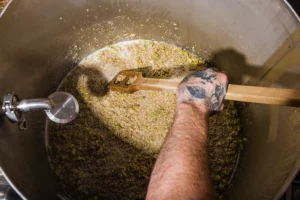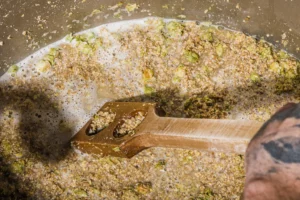Mash Hopping: An Introduction
Mash hopping is an old brewing technique that has recently received some renewed attention and study. Historically, mash hopping was used to create subtle and layered hop flavors predominantly in lighter styles like lager, pilsners, and pale ales. There were some big, boisterous IPA recipes that called for mash hops in order to pack in as much hoppy goodness as possible, but the popular opinion on the matter was that any of the mash hopping character was overshadowed by large kettle, whirlpool, and dry-hopping additions.
Recently, mash hopping has become a popular way to maximize fruit-forward compounds that many brewers are targeting in Hazy IPAs. In fact, Omega Yeast released a new yeast strain that is specifically meant to be used in conjunction with mash hopping. Cosmic Punch Yeast (OYL-402) was the first release in the Thiolized™ Series from Omega and this is how they describe it – “Our Thiolized process enhances a yeast’s natural ability to biotransform compounds found in malt and hops to unleash thiols that evoke grapefruit, passion fruit and guava aromas reminiscent of New Zealand Sauvignon Blanc and Southern Hemisphere Hops.”

What is Biotransformation?
Biotransformation is the process by which hop compounds are converted or changed into other aroma compounds. One such common conversion is geraniol into citronellol which is perceived as very vibrant citrus and sweet fruit in the finished beer.
Maximizing biotransformation in fruit-forward styles has been a popular brewing technique for many years with brewers selecting hops that are high in specific compounds. Varieties like Citra®, Cascade, Columbus, and Chinook are popular go-tos for both hot side and dry-hopping additions for highly sought-after biotransformation compounds.
There are two basic ways that biotransformation takes place. The most common is like with geraniol and citronellol where an aroma compound it transformed into a different aroma compound. The second form of biotransformation is when a bound aroma compound is released from its precursor form. This later form of biotransformation is what is being targeted during the mash hopping process because bound compounds are largely non-aromatic, but their released forms can be very aromatic even in small doses. These potent aroma compounds are called thiols.
What are Thiols?
Thiols are powerful aroma compounds that are made up of a sulfur atom that is bound with a hydrogen atom. Thiols and their important aromatic contribution have been well understood and studied by winemakers for decades, but just recently they have gotten the attention of brewers.
Thiols and precursors make up a very, very, very small percentage of the total hop compound composition, but humans have an incredibly low sensory threshold for thiols. That means that even in concentrations as low as parts per trillion, thiols can have a huge impact on aroma. Higher than average thiol contents in Australian hop varieties are one of the reasons for the region’s high impact hop varieties. These high thiol contents also help explain the signature big tropical fruit flavors in varieties like Galaxy® and Eclipse®. Citra® is another hop variety that has many different free thiols that are all present in above average concentrations.
Here are some of the most common thiols and their descriptors:
- 4-mercapto-4-methylpentant-2-one (4MMP) = Black currant and passion fruit
- 3-mercaptohexan-1-ol (3MH) = Citrus, rhubarb, exotic fruit
- 3-mercaptohexyl acetate (3MHA) = Passion fruit, guava, tropical fruit
- 3–Mercapto–octanal (3MO) = Peaches and stone fruit
- 3–Mercapto–4–methylpentan–1–ol (3M4MP) = Rhubarb and citrus
Free Thiols vs Bound Thiols
Thiols exist in two main forms. Free thiols are what can be perceived through sensory analysis. In contrast bound thiols are not able to be perceived and have no impact on flavor or aroma. Bound thiols are either cysteine-bound or glutathione-bound and cysteine-bound thiols must be converted through biotransformation before their aromatic potential can be unlocked.
Hops are not the only source of bound thiols, in fact malt has many magnitudes more bound thiols, but the glutathione-bound thiols must be converted to cysteine-bound thiols before they can undergo biotransformation and unlock their aroma. This conversion of bound thiols is what is trying to be achieved through mash hopping.
Mash Hopping Techniques
Even though there is a bunch of science happening behind the scenes, mash hopping is as easy as it sounds: just add hops to your mash! There is a wide range of hopping rates that go from half a pound up to two pounds of hops per barrel (1.30oz to 5.15oz in a 5 gallon batch). But the sweet spot seems to be right at one pound per barrel or 2.58oz in a 5 gallon batch.
Both pellet hops and whole cone hops can be used for mash hopping, but each should be used in a slightly different manner. Because pellet hops are ground up so finely, it is important to add them into a fine mesh bag. Normal mash temperatures are not hot enough to isomerize any of the alpha acids in hops, but if some of the fine pellet material does make it into your wort during boil, then there will be some unintentional bitterness.
One added bonus of keeping your pellet hops in a fine mesh bag during mash hopping is that they can do double duty and be added back in during your boil as your bittering addition. Again, since mash temperatures are not high enough to isomerize the alpha acids, any hops used for mash hopping will retain all of their bittering potential.

Whole cone hops have an added bonus in that if they are mixed in with the grains they will help give good structure to your grain bed and act in a similar way as rice hulls. This will help during lautering and help avoid getting a stuck mash. The downside to mixing the hop cones in with your grains is that you will not be able to reuse the hops on the hotside, but your improved mash efficiency might be worth it.
Top Hops for Mash Hopping
Whether you choose pellet hops or whole cones the most important decision will definitely be what hop variety to use. Here are our top suggestions for mash hopping varieties:
- Czech Saaz
- Cascade
- German Perle
- Hallertauer Mittelfrüh
Mash Hopping Q&A
Q: Is it better to use pellets or whole cone hops for mash hopping?
A: Both have their own benefits. Traditionally whole cone hops are used and can help with lautering, but pellet hops in a fine mesh bag can be reused on the hot side for your bittering addition.
Q: Does mash hopping contribute to bitterness in the final beer?
A: Mash temperatures are not high enough to isomerize any of the alpha acids, but if you use pellet hops, some of the fine material might not be fully filtered out, meaning that it will remain in your wort during boil and contribute some unintended bitterness.
Q: Does mash hopping benefit beers even if Cosmic Punch Yeast is not used?
A: Many brewers used mash hopping previously to create subtle, complex, and layered hop flavors. And while traditional ale and lager strains do perform biotransformation, Cosmic Punch Yeast by Omega is genetically engineered to produce β‑lyase enzyme that helps free bound thiols.
Q: If mash hops are kept in a hop sock can they be reused on the hot side?
A: Yes. Many of the flavor and aroma compounds will no longer be present in hops used for mash hopping, but non-isomerized alpha acids are not soluble in water so they will still retain their bittering potential.
Sources and Citations:
1. Andrew J King, J. Richard Dickinson, Biotransformation of hop aroma terpenoids by ale and lager yeasts, FEMS Yeast Research, Volume 3, Issue 1, March 2003, Pages 53–62, https://doi.org/10.1111/j.1567-1364.2003.tb00138.x [https://academic.oup.com/femsyr/article/3/1/53/590891]
2. Development of Thiols and Thiol Precursors in different Hop varieties during Hop Harvest and their impact on beer flavor – CBC 2020 Presentation by Dr. Christina Schönberger, Head of Innovation/Education BarthHaas Germany and Laurent Dagan, Nyseos, France. [https://www.brewersassociation.org/wp-content/uploads/2020/05/CBC-Online-Seminar-Presentation-Development-of-Thiols-and-Thiol-Precursors-in-Different-Hop-Varieties.pdf]
Special Thanks to David for finding this article!
